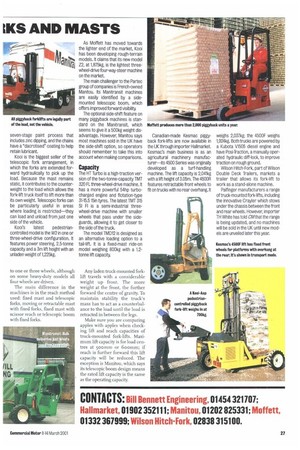Piggyback fork-lifts eat into payload potential but they also allow
Page 28

Page 29

If you've noticed an error in this article please click here to report it so we can fix it.
drivers to unload trucks single-handed and could help win new business. Sharon Clancy reviews the options.
Truck-mounted forklifts have an image problem in the UK. They are acknowledged as useful tools when delivering to farms and large building sites, and are in widespread use in sectors such as agriculture, building supplies and poultry farming. However, although this equipment is popular on the Continent for general haulage work, UK operators have been deterred by high capital costs and the perceived weight penalty.
Truck-mounted fork-lift manufacturers say attitudes are gradually changing and they cite the machines' numerous advantages; drivers do not have to wait to be tipped and can make unattended deliveries; the machine can be carried by several trucks in the fleet; the load can be taken precisely where it is needed, improving service and reducing the customers' own materials handling costs; servicing the fork-lift can be handled without taking the host truck off the road, and fleet size can be reduced.
Kevin Hignett, managing director at Moffett, which makes the Mounty piggyback fork-lift, believes operators who use truckmounted cranes could benefit from switching to truck-mounted fork-lifts. "The fork-lift is demountable, which increases the payload flexibility on a truck," he says. "Even if you do not need the crane, it is permanently attached to the truck, taking up payload."
It is true that truck-mounted fork-lifts typically weigh between 1.5 and 2.5 tonnes, but weights are coming down. A Kooi pedestrian-controlled truck-mounted fork-lift weighs 70 okg, and Manitou's new TM Dm ride-on model weighs in at 800kg.
The capital cost— which starts at fi5,000 but is more likely to be £20,000 for ride-on machines—can still be prohibitive. But service lives are between to and 15 years, and maintenance costs are low. Manitou is among the manufacturers to offer finance packages.
A truck-mounted fork-lift is a ride-on or pedestriancontrolled reach truck, often featuring telescopic forks and a retractable or scissor mast or a telescopic boom to do the lifting. During transit it travels on the rear of the truck—hence the popular name of piggyback truck—and legally is considered part of the load, not the vehicle. A piggyback truck typically increases the rear overhang by at least 900rrnn.
With the exception of a few electrically powered industrial models, most truck-mounted fork-lifts have either Kubota or Lister Petter diesel engines, with outputs ranging from ighp to 39hp, depending on the model. Hydrostatic drive is universal on truck-mounted fork-lifts usually
to one or three wheels, although on some heavy-duty models all four wheels are driven.
The main difference in the machines is in the reach method used: fixed mast and telescopic forks, moving or retractable mast with fixed forks, fixed mast with scissor reach or telescopic boom with fixed forks. Any laden truck-mounted forklift travels with a considerable weight up front. The more weight at the front, the further forward the centre of gravity. To maintain stability the truck's mass has to act as a counterbalance to the load until the load is retracted in between the legs.
Make sure you are comparing apples with apples when checking lift and reach capacities of truck-mounted fork-lifts. Maximum lift capacity is for load centres at 500mm or Goomm; if reach is further forward this lift capacity will be reduced. The exception is Manitou, which says its telescopic boom design means the rated lift capacity is the same as the operating capacity.
































































































